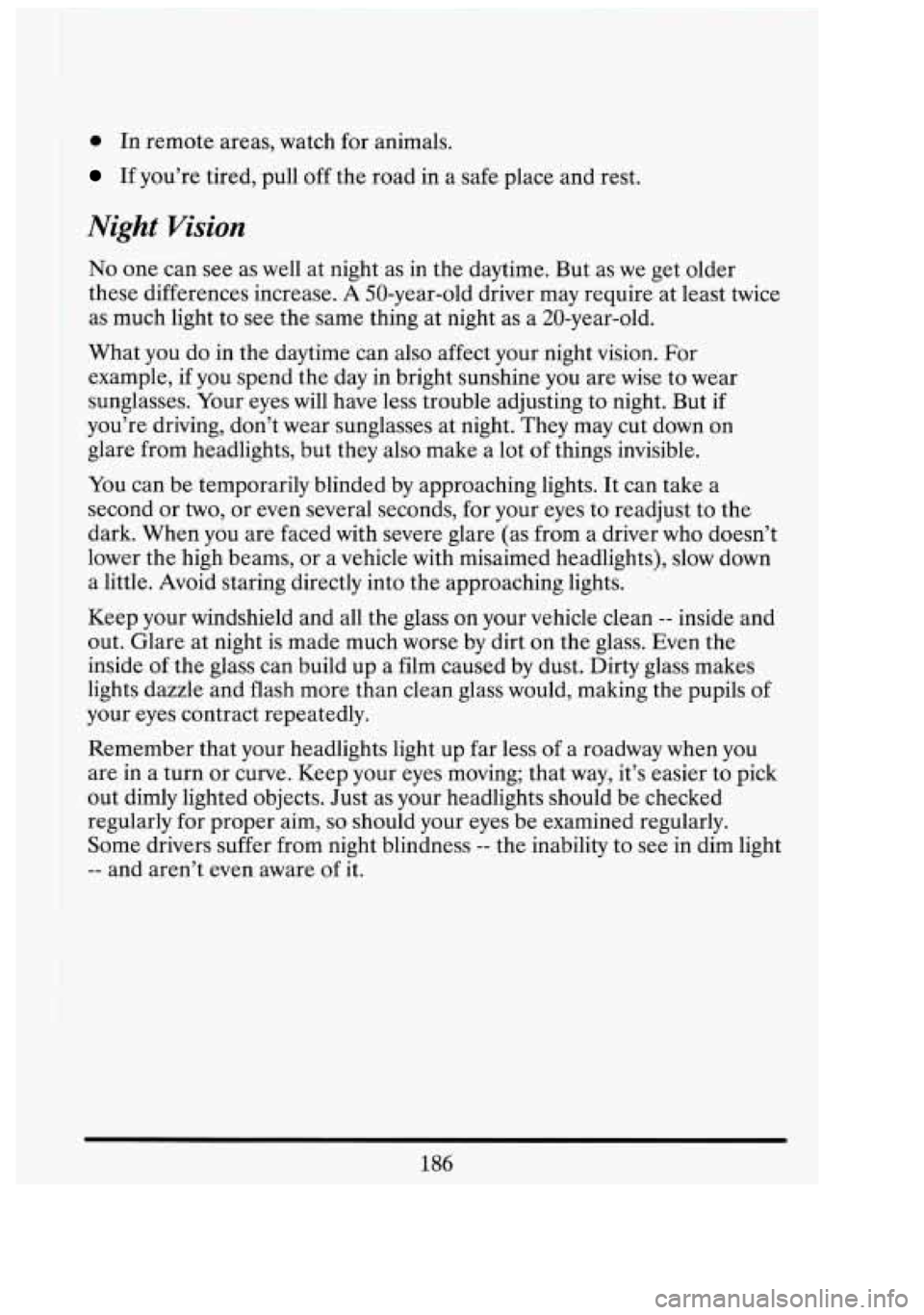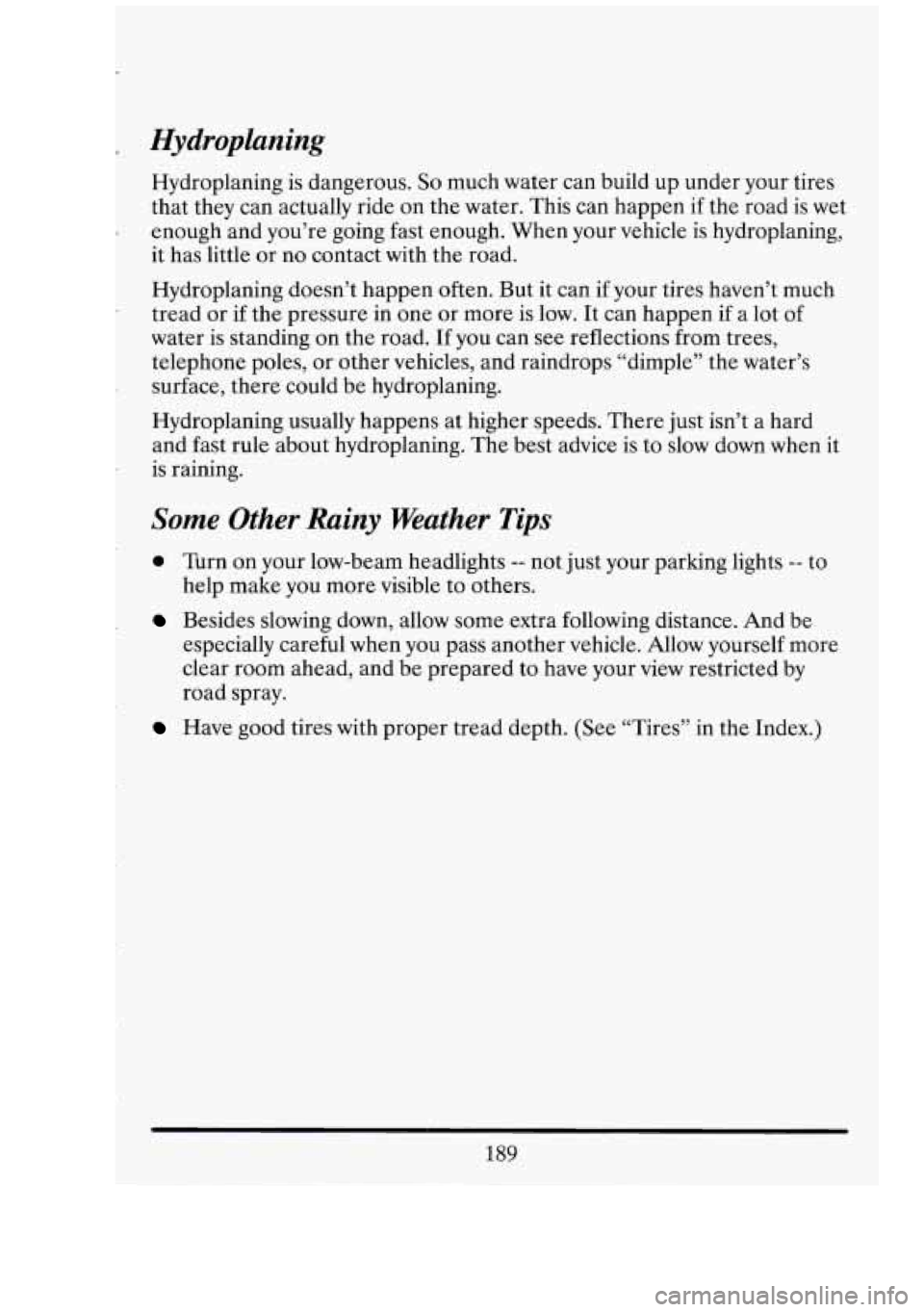Page 17 of 398
These symbols have to do with your lights:
a
pf t
I PARKING LIGHTS u
TURN SIGNALS
MASTER LIGHTING
SWITCH I
A
;tD
I
LIGHTS OR HIGH BEAM I I I
HAZARD WARNING FLASHER
I LAMPS I
These symbols are on some of your controls:
B d
1
I I
WINDSHIELD
WIPER h WASHER I
WINDSHIELD WASHER I I
WINDSHIELD
DEFROSTER I I
I VENTILATING FAN I HEADLAMP
WASHER WIPER
REAR WINDOW
DEFOGGER
3'
4
Page 118 of 398
The lever on the left side of the steering column includes your:
0 Turn Signal and Lane Change Indicator
0 Headlight High-Low Beam & Passing Signal
Windshield Wipers
0 Windshield Washer
Cruise Control
Turn Signal and Lane Change Indicator
To signal a turn, move
the lever all the way up
or down. When the
turn is finished, the
lever
will return
automatically.
To signal a lane change. slightly move the lever up or down. When the
lane change is finished release the lever.
105
Page 120 of 398

jurisdictions prohibit driving solely with parking lights, especially at dawn
or dusk. It is recommended that you check with your own state or
provincial highway authority for applicable lighting regulation.
Headlight High-Low Beam
To change the
headlights from low
beam to high or high to
low, pull the turn signal
lever all the way toward
you. Then release it.
When the high beams
are on, this blue light
on the instrument
panel also will be on.
Flash-To-Pass Feature
This lets you use your high beam headlights to signal a driver in front of
you that you want to pass. It works even if your headlights are off.
To use it, pull the multifunction lever toward you. When you do:
If your headlights are off Your high beam headlights will turn on. They’ll
stay on as long as you hold the lever there. Release the lever to turn them
off.
If your headlights are on. but on low beam: The system works normally.
Just pull the lever. Your headlights will shift to high beam and stay there.
To return to low beam, just pull the lever toward you.
If your headlights are on. and on high beam: Your headlights will switch
to low beam.
To get back to high beam, pull the lever toward you.
107
Page 131 of 398

If you cover the sensor, it will sense that it is dark outside and your lights
will come on.
Cornering Lights
If your exterior lights are on, the cornering lights will come on when you
signal a turn. This will provide more light for cornering when its dark.
Underhood Light
Your vehicle has a Delay Interior Lighting System (DIL). This system
controls power to the underhood light. Just pull up on the door handle
,with the hood raised and the lamp will light for about
10 minutes.
Every time the door handle is pulled up the light will stay on another
10 minutes. The light will go off when you close the hood.
Daytime Running Lights (Canada Only)
The Canadian Federal Government has decided that “Daytime Running
Lights’’ (DRL) are a useful feature, in that DRL can make your vehicle
more visible to pedestrians and other drivers during daylight hours. DRL
are required on new vehicles sold in Canada.
Your DRL work with a light sensor on top of the instrument panel. Don’t
cover it up.
The high beam headlights will come on at reduced brightness in daylight
when:
0 The ignition is on
0 The headlight switch is off, and
The transmission is not in “P” (Park).
At dusk, the DRL will switch
off and the exterior lights will come on
automatically. At dawn, the exterior lights will go out and the high beams
will change to the reduced brightness of DRL (if the headlight switch is
Of course, you may still turn
on the headlights any time you need to.
To idle your vehicle with the DRL off, shift the transmission into “P”
(Park), turn the ignition OFF, and then restart your engine. The DRL will
stay off until you shift out of “P” (Park).
off).
01
I
l
I
i
118
Page 132 of 398
Reading Lights
Here's where you turn them on:
Lamp Monitors
The front lamp
monitors show that
your headlamps, high
beams and turn signals
are working.
119
Page 199 of 398

0 In remote areas, watch for animals.
If you’re tired, pull off the road in a safe place and rest.
Night Vision
No one can see as well at night as in the daytime. But as we get older
these differences increase. A 50-year-old driver may require at least twice
as much light to see the same thing at night as a 20-year-old.
What you do in the daytime can also affect your night vision. For
example, if you spend the day in bright sunshine you are wise to wear
sunglasses. Your eyes will have less trouble adjusting to night. But if
you’re driving, don’t wear sunglasses at night. They may cut down on
glare from headlights, but they also make a lot
of things invisible.
You can be temporarily blinded by approaching lights. It can take a
second or
two, or even several seconds, for your eyes to readjust to the
dark. When you are faced with severe glare (as from a driver who doesn’t
lower the high beams,
or a vehicle with misaimed headlights), slow down
a little. Avoid staring directly into the approaching lights.
Keep your windshield and all the glass on your vehicle clean
-- inside and
out. Glare at night is made much worse by dirt on the glass. Even the
inside
of the glass can build up a film caused by dust. Dirty glass makes
lights dazzle and flash more than clean glass would, making the pupils
of
your eyes contract repeatedly.
Remember that your headlights light up far less
of a roadway when you
are in
a turn or curve. Keep your eyes moving; that way, it’s easier to pick
out dimly lighted objects. Just as your headlights should be checked
regularly for proper aim,
so should your eyes be examined regularly.
Some drivers suffer from night blindness
-- the inability to see in dim light
-- and aren’t even aware of it.
186
c3
I
Page 202 of 398

Hydroplaning
Hydroplaning is dangerous. So much water can build up under your tires
that they can actually ride on the water. This can happen
if the road is wet
enough and you’re going fast enough. When your vehicle is hydroplaning,
it has little or no contact with the road.
Hydroplaning doesn’t happen often. But it can
if your tires haven’t much
tread or
if the pressure in one or more is low. It can happen if a lot of
water is standing on the road. If you can see reflections from trees,
telephone poles, or other vehicles, and raindrops “dimple” the water’s
surface, there could be hydroplaning.
Hydroplaning usually happens at higher speeds. There just isn’t a hard
and fast rule about hydroplaning. The best advice is to slow down when it
is raining.
Some Other Rainy Weather Tips
0 Turn on your low-beam headlights -- not just your parking lights -- to
help make you more visible to others.
Besides slowing down, allow some extra following distance. And be
especially careful when you pass another vehicle. Allow yourself more
clear room ahead, and be prepared to have your view restricted by
road spray.
Have good tires with proper tread depth. (See “Tires” in the Index.)
189
Page 330 of 398

.
BULB. CILL4RT .
.
.
.
.
.
.
.
You can get these from your Cadillac dealer .
DESCRIPTION BULB NO .
Ash Tray Illumination .................................. 1445
Center High Mounted Stop Light
........................ 1141
Cornering Light
....................................... 2057
BackupLights
......................................... 2057
Courtesy Light
. Front Door ............................ S214-2
Courtesy Light
. Rear Door ............................ S214-2
CourtesyMap Light
..................................... 192
Front Parking
& Directional Signal .................... 2057NA
Front Side Marker Light
................................. 194
Glove Box
............................................. 194
Headlight High Beam
...................... 906/HB4 (H2990 4)
Headlight Low Beam
....................... 905/HB3 (K1790 3)
License Plate Light ..................................... 194
Side Marker Lights
..................................... 194
Stop, Tail.
& Directional Signal Light ..................... 2057
TrunkLight
......................................... 5 92081
Vanity Mirror Light
..................................... 194
Parking
Light
.......................................... 2057
Underhood Light
........................................ -93
317